Numerical Study on Mechanical Behaviors of New Type of Steel Shear-Connection Horizontal Joint in Prefabricated Shear Wall Structure
Abstract
:1. Introduction
2. Design of the New Steel Shear-Connection Joint
3. Numerical Model and Validation
3.1. Constitutive Relationship of Concrete and Steel Materials
3.1.1. Constitutive Relationship of Steel Material
3.1.2. Constitutive Relationship of Concrete Material
3.2. Validation of a Numerical Model
3.3. Model Establishment of the SSCH Joint
4. Parameter Effect of the SSCH Joint
4.1. Calculation Cases
4.2. Effect of the Length of the Interlocking Slot
4.3. Effect of the Number of the Interlocking Slot
4.4. Effect of the Thickness of the Interlocking Slot
4.5. Effect of the Axial Compression Ratio
5. Simplified Constitutive Model of the SSCH Joint
5.1. Theory Deduction
5.2. Result Discussion
6. Conclusions
Author Contributions
Funding
Data Availability Statement
Acknowledgments
Conflicts of Interest
References
- Singhal, S.; Chourasia, A.; Chellappa, S.; Parashar, J. Precast reinforced concrete shear walls: State of the art review. Struct. Concr. 2019, 20, 886–898. [Google Scholar] [CrossRef]
- Hemamalini, S.; Vidjeapriya, R.; Jaya, K.P. Performance of precast shear wall connections under monotonic and cyclic loading: A state-of-the-art review. Iran. J. Sci. Technol.-Trans. Civ. Eng. 2021, 45, 1307–1328. [Google Scholar] [CrossRef]
- Men, J.J.; Shi, Q.X.; He, Z.J. Optimal design of tall residential building with RC shear wall and with rectangular layout. Int. J. High-Rise Build. 2014, 3, 285–296. [Google Scholar]
- Chu, M.; Liu, J.; Sun, Z. Experimental study on mechanical behaviors of new shear walls built with precast concrete hollow moulds. Eur. J. Environ. Civ. Eng. 2019, 23, 1424–1443. [Google Scholar] [CrossRef]
- Ali, M.M.; Osman, S.A.; Husam, O.A. Numerical study of the cyclic behavior of steel plate shear wall systems (SPSWs) with differently shaped openings. Steel Compos. Struct. 2018, 26, 361–373. [Google Scholar]
- Mao, H.; Qin, G.C.; Lan, T. Study on the seismic performance of box-plate steel structure modular unit. Adv. Mater. Sci. Eng. 2019, 4, 4561631. [Google Scholar] [CrossRef]
- Nguyen, N.H.; Whittaker, A.S. Numerical modelling of steel-plate concrete composite shear walls. Eng. Struct. 2017, 150, 1–11. [Google Scholar] [CrossRef]
- Chu, M.; Wang, B.; Liu, J.; Zhang, P.; Li, X.; An, N. Experimental study on mechanical behavior of precast concrete shear walls with mortise-tenon joints. J. Build. Struct. 2021, 42, 173–182. [Google Scholar]
- Nie, J.-G.; Hu, H.-S.; Fan, J.-S.; Tao, M.-X.; Li, S.-Y.; Liu, F.-J. Experimental study on seismic behavior of high-strength concrete filled double-steel-plate composite walls. J. Constr. Steel Res. 2013, 88, 206–219. [Google Scholar] [CrossRef]
- Wang, D.Y.; Xu, S.C.; Yang, Y.; Mao, J.H.; Zhu, Y.; Guo, D.W.; Nie, Z.L. Study on seismic behaviors of steel–concrete composite shear walls with novel corner designs. J. Build. Eng. 2023, 70, 106339. [Google Scholar] [CrossRef]
- Han, Q.H.; Wang, D.Y.; Zhang, Y.S.; Tao, W.J. Experimental investigation and simplified stiffness degradation model of precast concrete shear wall with steel connectors. Eng. Struct. 2020, 220, 110943. [Google Scholar] [CrossRef]
- Soudki, K.A.; West, J.S.; Rizkalla, S.H.; Blackett, B. Horizontal connections for precast concrete shear wall panels under cyclic shear loading. PCI J. 1996, 41, 64–80. [Google Scholar] [CrossRef]
- Zhao, B.; Wang, Q.; Lu, X. Research on seismic behavior of precast concrete walls with fully assembled horizontal joints. J. Build. Struct. 2018, 39, 48–55. [Google Scholar]
- Cheng, B.; Cai, Y.; Looi, D.T.W. Experiment and numerical study of a new bolted steel plate horizontal joints for precast concrete shear wall structures. Structures 2021, 32, 760–777. [Google Scholar] [CrossRef]
- Wei, H.; Li, Q. Experimental study on seismic behavior of prefabricated RC shear walls with horizontal joints welded by steel plates. J. Build. Struct. 2020, 41, 77–87. [Google Scholar]
- Perez, F.J.; Pessiki, S.; Sause, R. Lateral load behavior of unbonded post-tensioned precast concrete walls with vertical joints. PCI J. 2004, 49, 48–64. [Google Scholar] [CrossRef]
- Chu, M.; Xiong, C.; Liu, J.; Sun, Z. Experimental study on shear behavior of two-way hollow core precast panel shear wall with vertical connection. Struct. Des. Tall Spec. Build. 2021, 30, e1814. [Google Scholar] [CrossRef]
- Huang, W.; Miao, X.W.; Zhao, Y.Y.; Yu, G.; Zhang, J.R.; Fan, Z.H. Experimental study on seismic performance of fully assembled composite walls with vertical joints using different dry connections. J. Build. Struct. 2020, 41 (Suppl. 2), 114–122. [Google Scholar]
- Li, H.; Chen, W.; Huang, Z.; Hao, H.; Ngo, T.T.; Pham, T.M.; Yeoh, K.J. Dynamic response of monolithic and precast concrete joint with wet connections under impact loads. Eng. Struct. 2020, 250, 113434. [Google Scholar] [CrossRef]
- Zhu, G.; Ma, Y.X.; Tan, K.H. Experimental and analytical investigation on precast concrete-encased concrete-filled steel tube column-to-column dry connections under axial tension. Structures 2022, 45, 523–541. [Google Scholar] [CrossRef]
- Li, W.; Gao, H.; Xiang, R.; Du, Y. Experimental study of seismic performance of precast shear wall with a new bolt-plate connection joint. Structures 2021, 34, 3818–3833. [Google Scholar] [CrossRef]
- Fu, Y.; Fan, G.; Tao, L.; Yang, Y.; Wang, J. Seismic behavior of prefabricated steel reinforced concrete shear walls with new type connection mode. Structures 2022, 37, 483–503. [Google Scholar] [CrossRef]
- Xue, W.C.; Li, Y.; Cai, L.; Hu, X. Seismic Performance of Precast Concrete Composite Shear Walls with Multiple Boundary Elements. J. Earthq. Tsunami 2019, 13, 1940006. [Google Scholar] [CrossRef]
- Fintel, M. Performance of buildings with shear walls in earthquakes of the last thirty years. PCI J. 1995, 40, 62–80. [Google Scholar] [CrossRef]
- Guo, Z.H. Principles of Reinforced Concrete Structure; Science Press: Beijing, China, 1998. [Google Scholar]
- Qian, J.R.; Zhao, Z.Z.; Duan, A.; Xia, Z.F.; Wang, M.D. Pesudo-dynamic tests of a 1:10 model of pre-stressed concrete containment vessel for CNP 1000 nuclear power plant. China Civ. Eng. J. 2007, 40, 7–13. [Google Scholar]
- Birtel, V.; Mark, P. Parameterised finite element modelling of RC beam shear failure. In Proceedings of the 19th Annual International ABAQUS Users’ Conference, Boston, MA, USA, 23–25 May 2006; pp. 95–108. [Google Scholar]
- Qian, J.R.; Zao, J.; Ji, X.D. Experimental study on seismic behavior of steel tube-reinforced concrete composite shear walls with high axial compressive load ratio. J. Build. Struct. 2010, 31, 5–13. [Google Scholar]
- Gao, L.B.; Chen, Q.G. An anisotropic damage constitutive model for concrete and its applications. Appl. Mech. 1988, 65, 578–583. [Google Scholar]
- GB 50017-2017; Standard for Design of Steel Structures. China Architecture and Building Press: Beijing, China, 2017.
- Wang, X.W.; Sun, L. Research on the performance of steel frame semi rigid connections. J. Wuhan Univ. Technol. 2002, 21, 65–72. [Google Scholar]
- Qian, J.R.; Liu, X.M. Test of seismic behavior of FRP-concrete-steel double-skin tubular columns. China Civ. Eng. J. 2008, 41, 29–36. [Google Scholar]
- Seible, F.; Priestley, M.J.N.; Hegemier, G.A. Seismic retrofit of RC columns with continuous carbon fiber jackets. J. Compos. Constr. 1997, 1, 52–62. [Google Scholar] [CrossRef]
- Qian, J.R.; Liu, X.M. A hysteretic model of moment-rotation relationship for plastic hinge zone of FRP-concrete-steel double shin tubular columns. Eng. Mech. 2008, 25, 48–52. [Google Scholar]

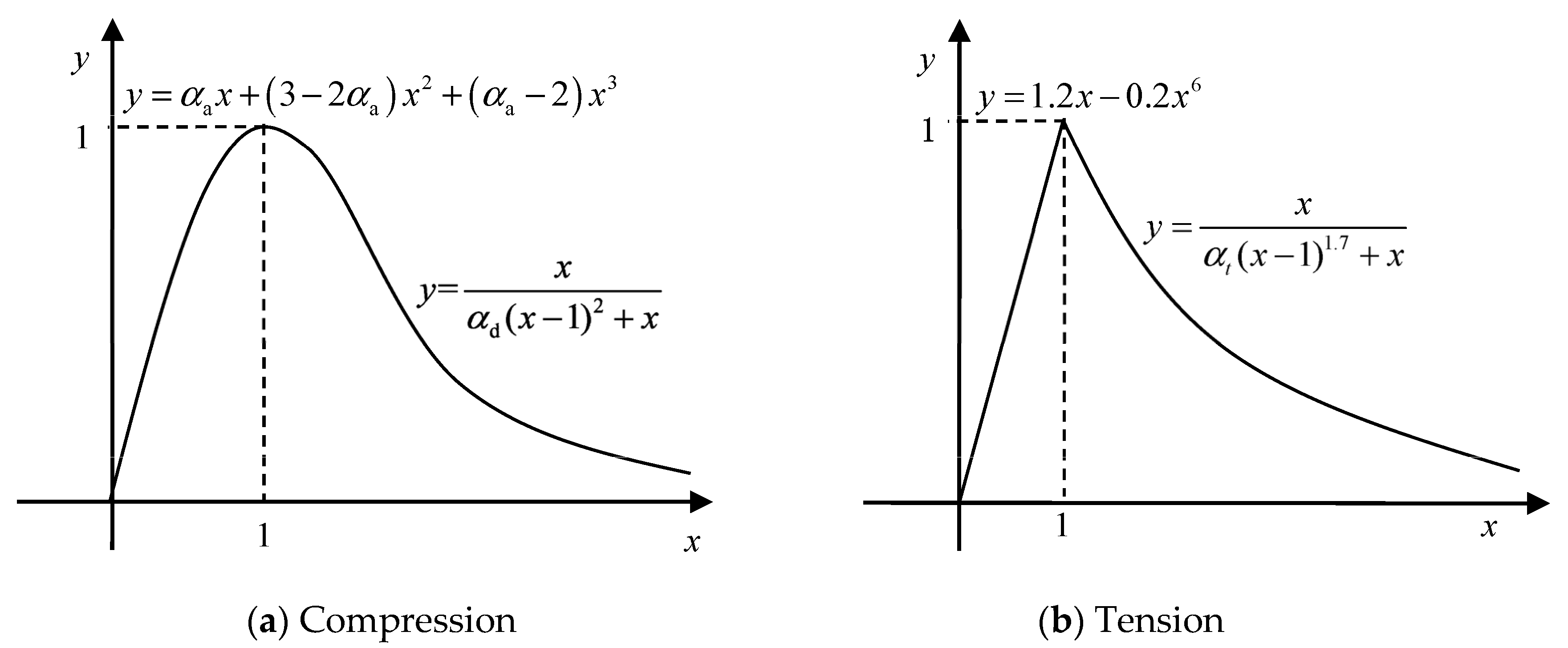
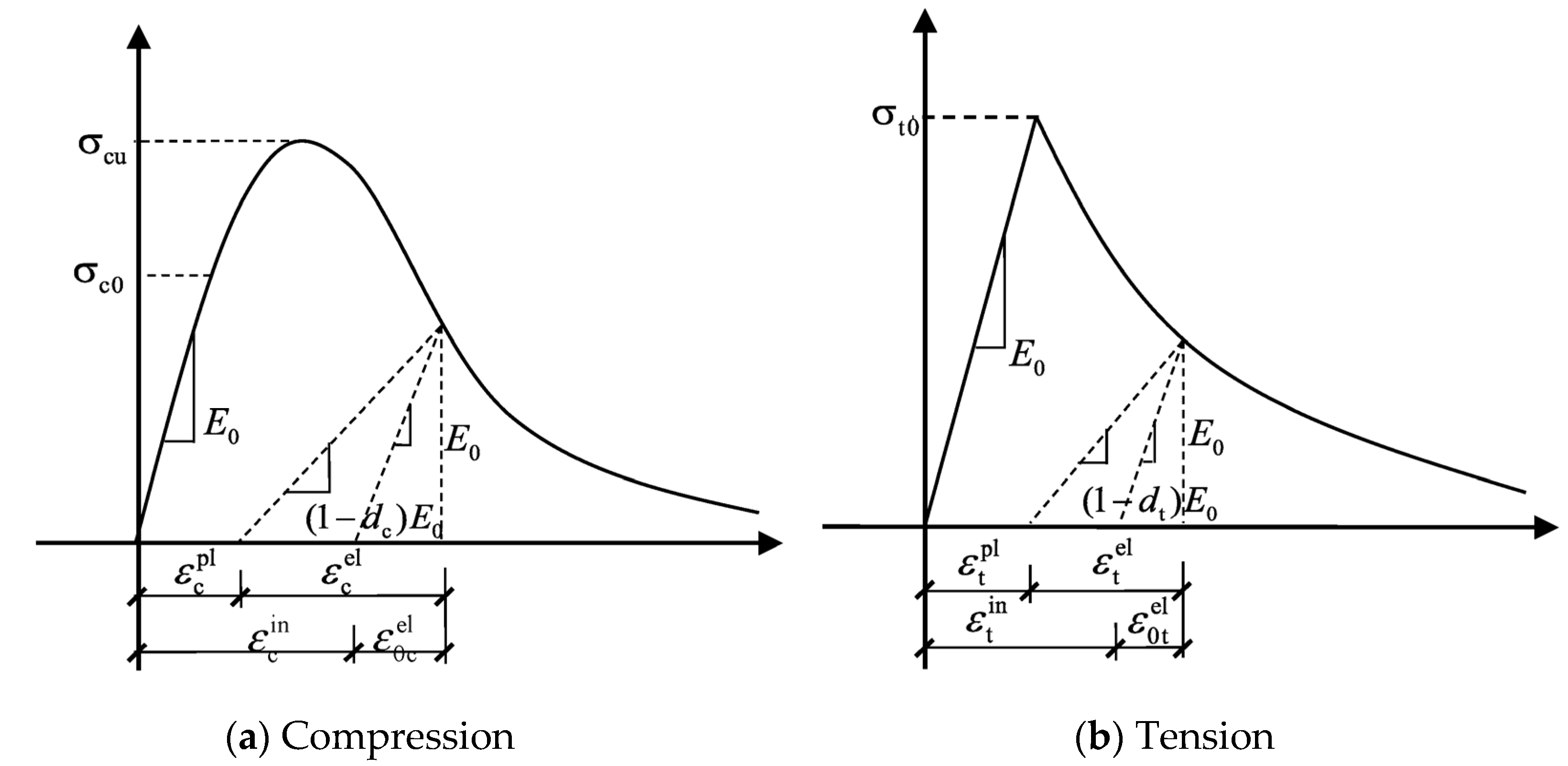
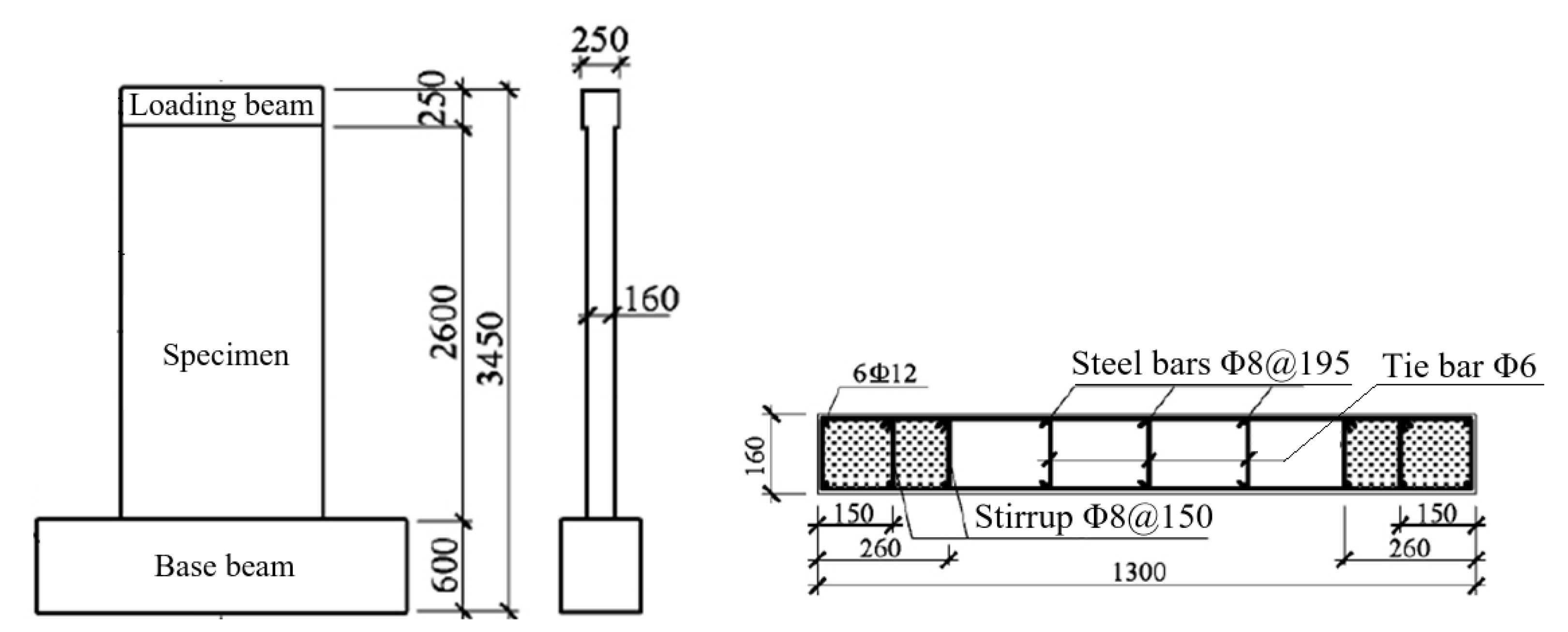


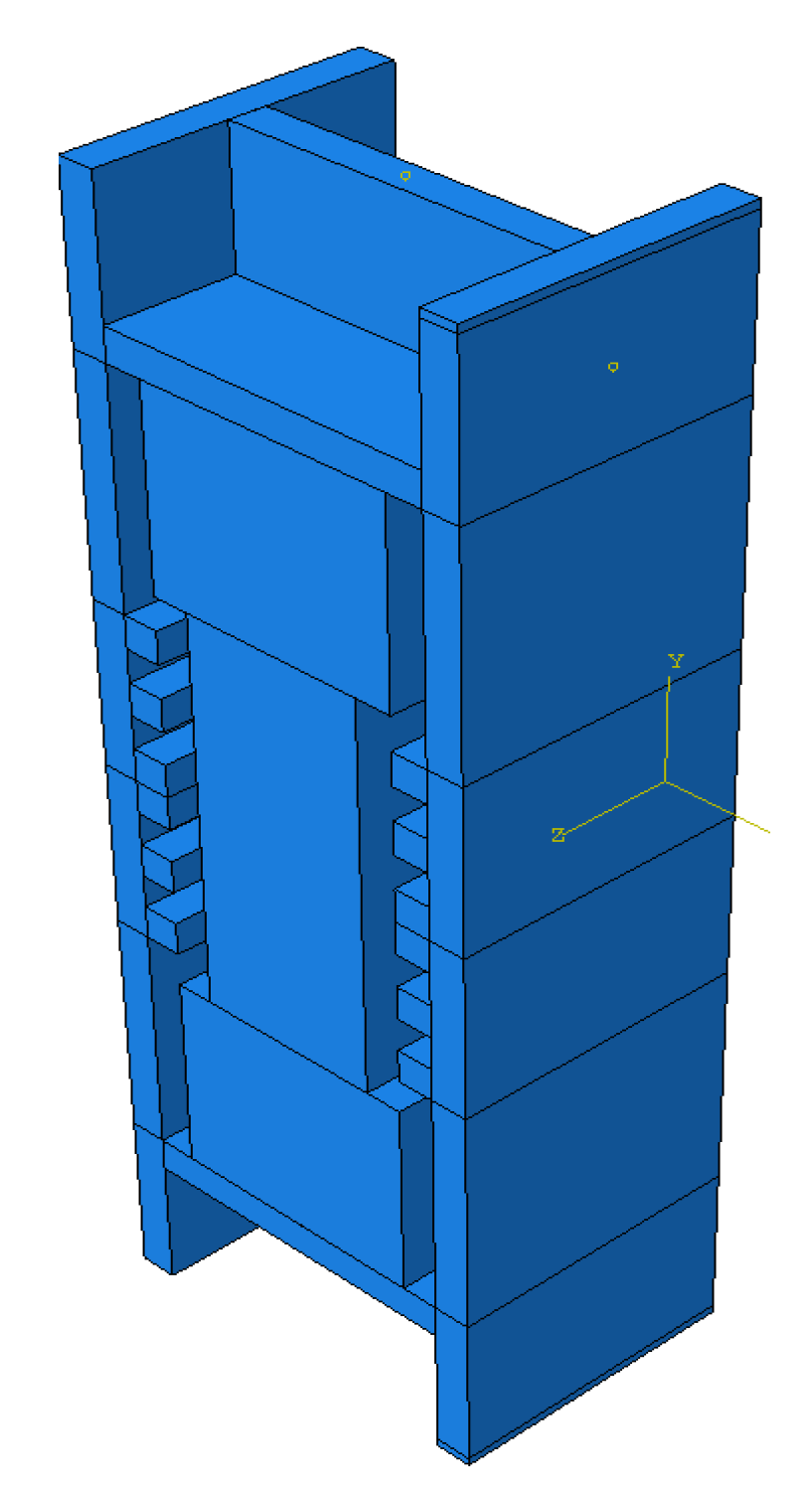
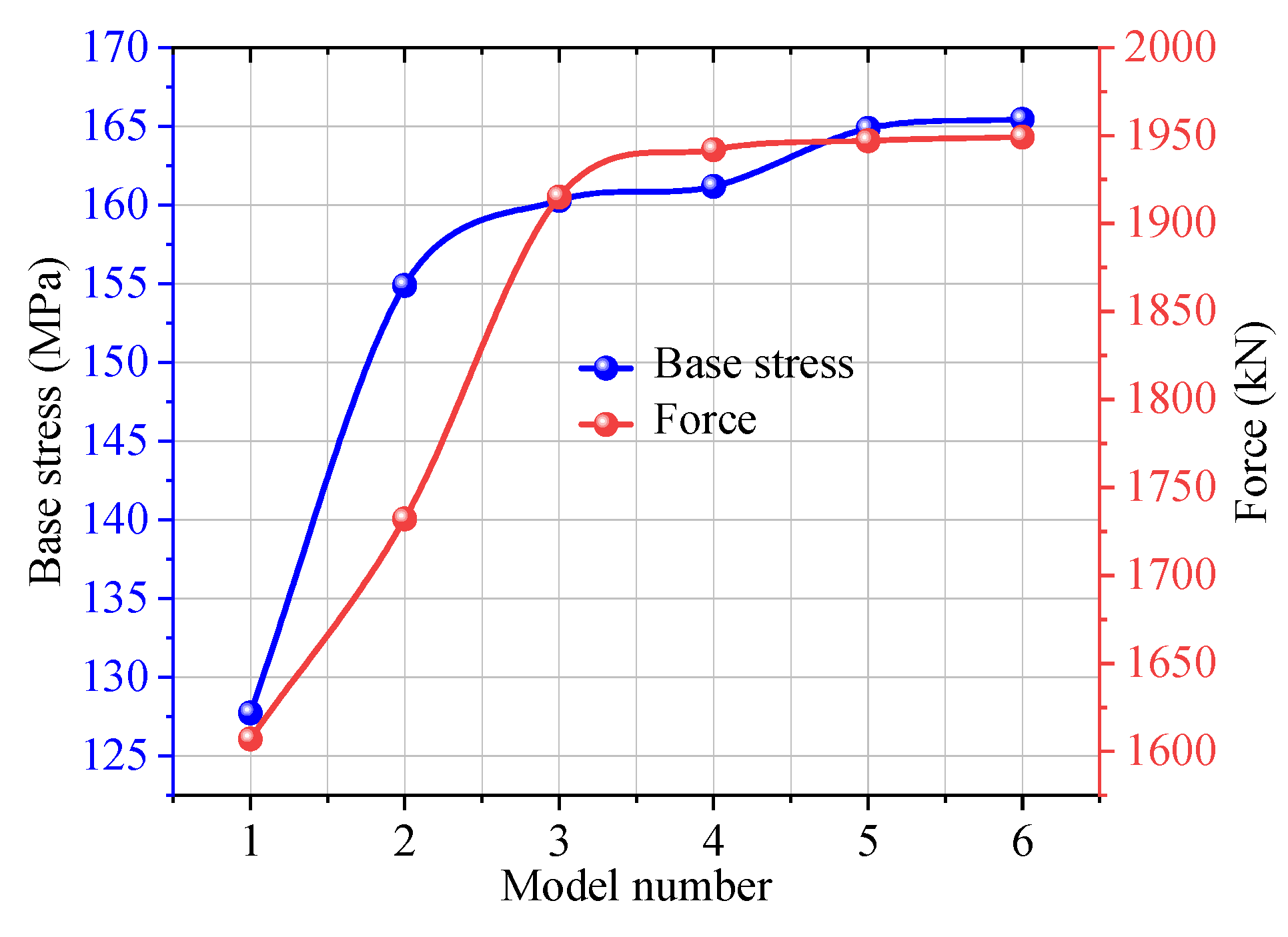

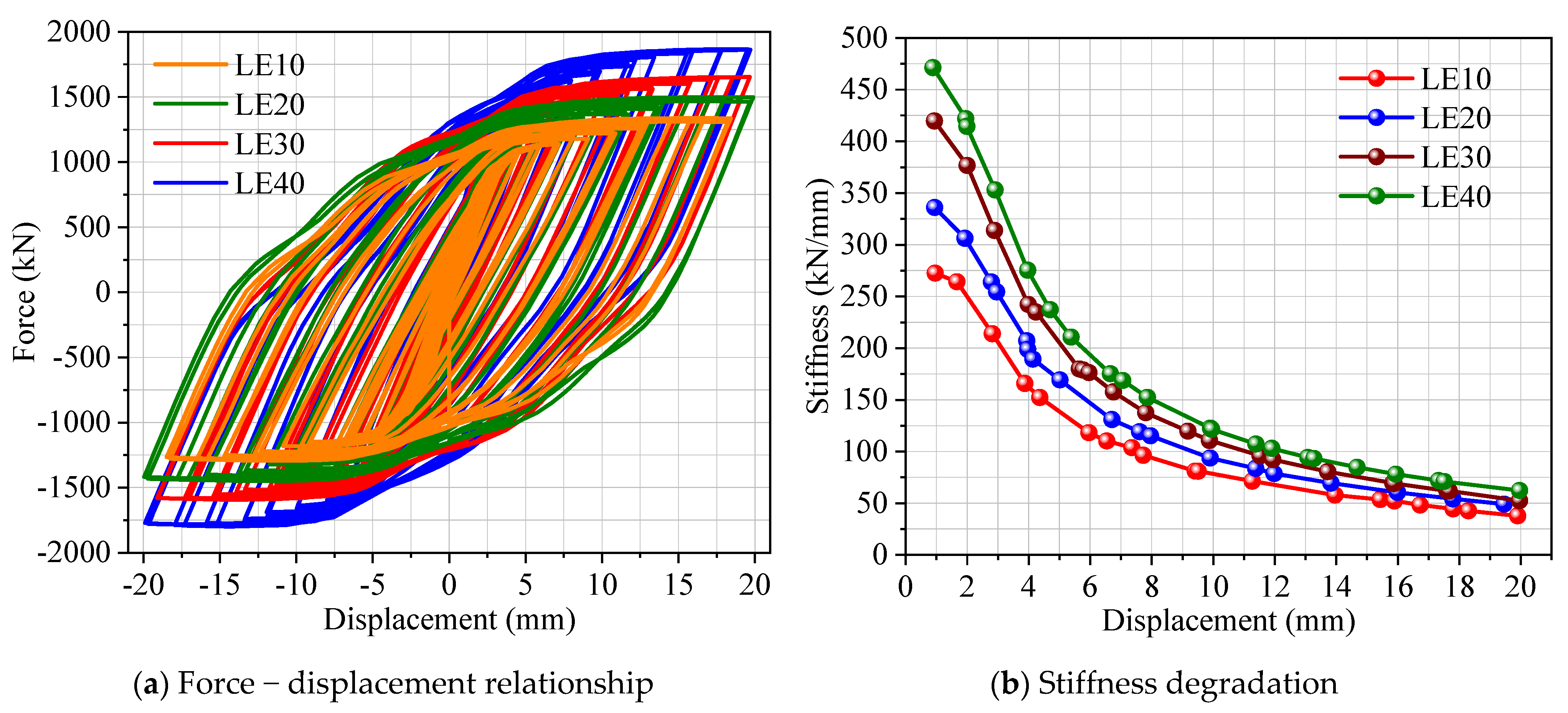

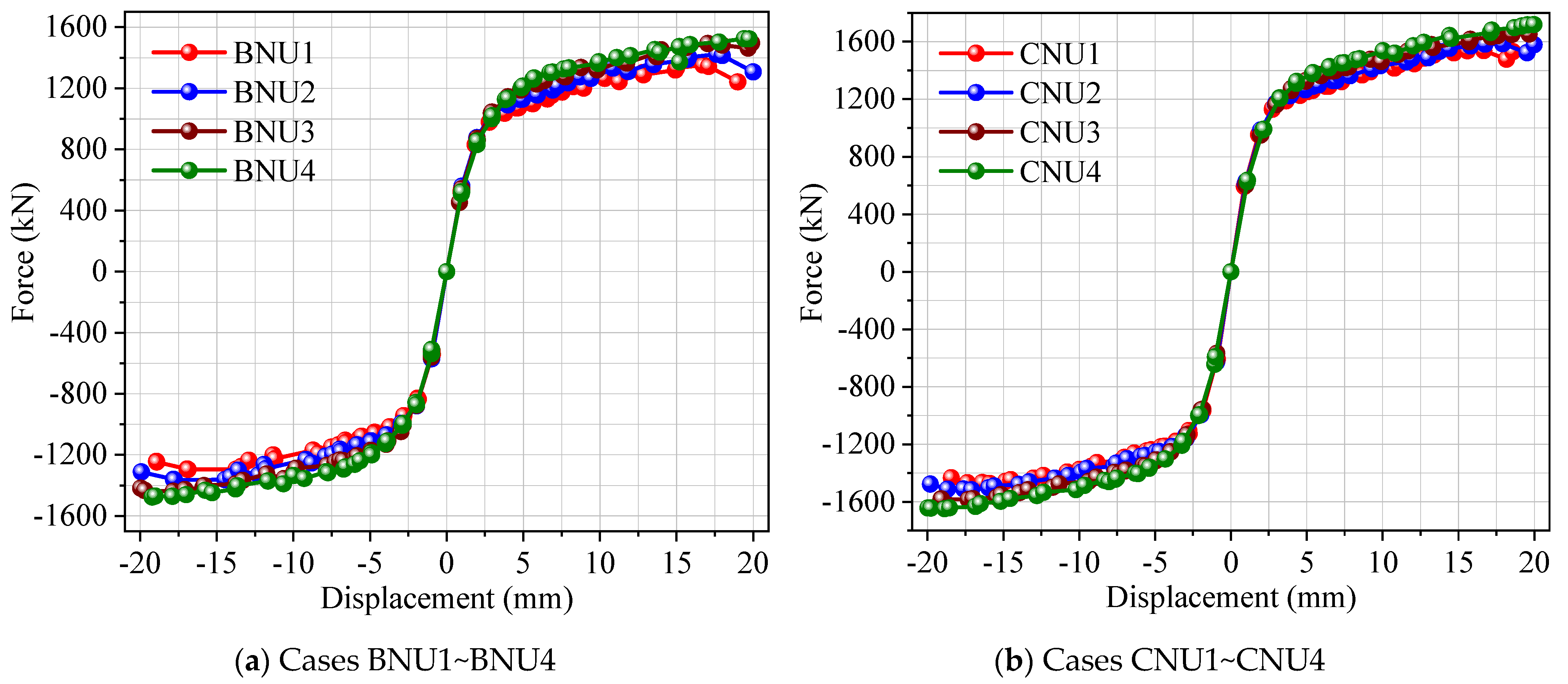
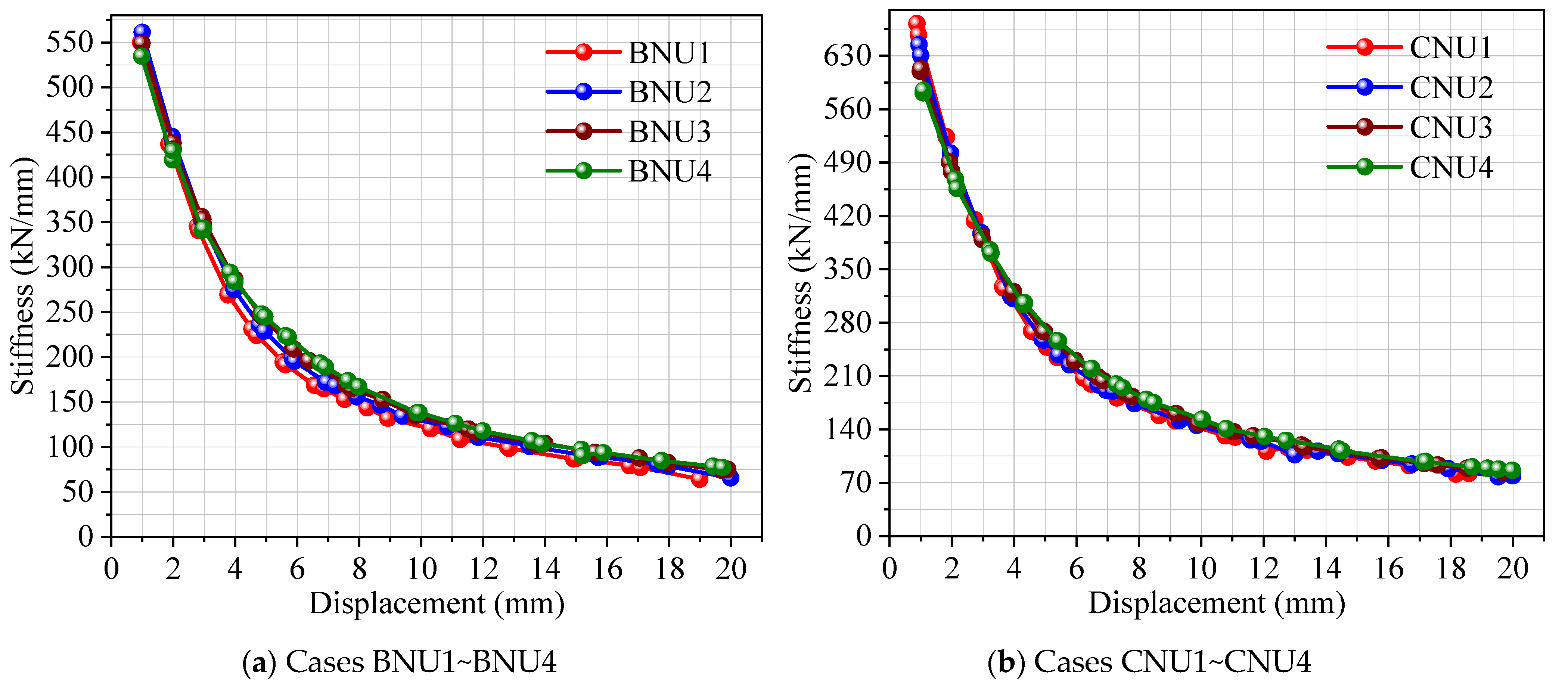

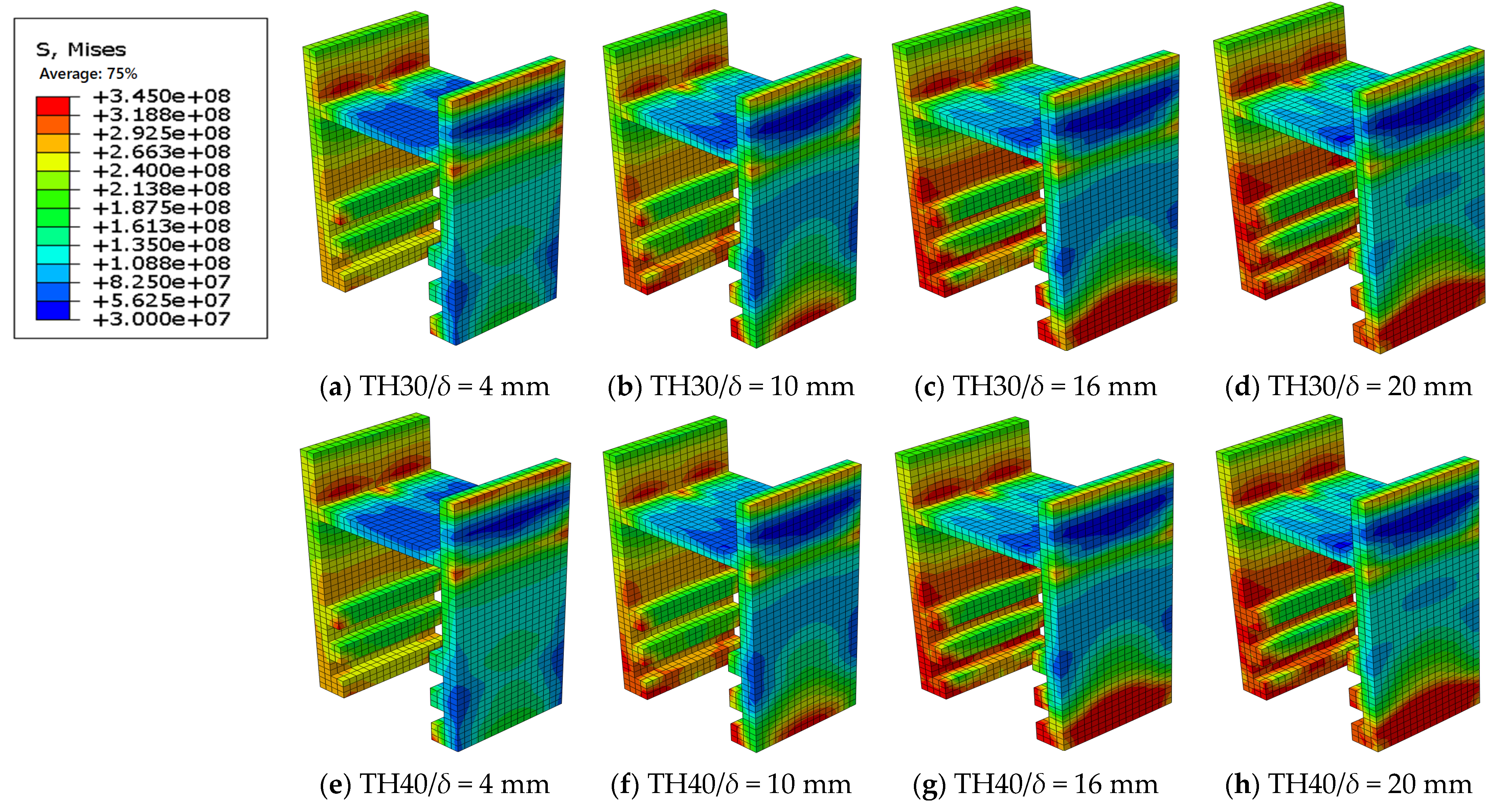
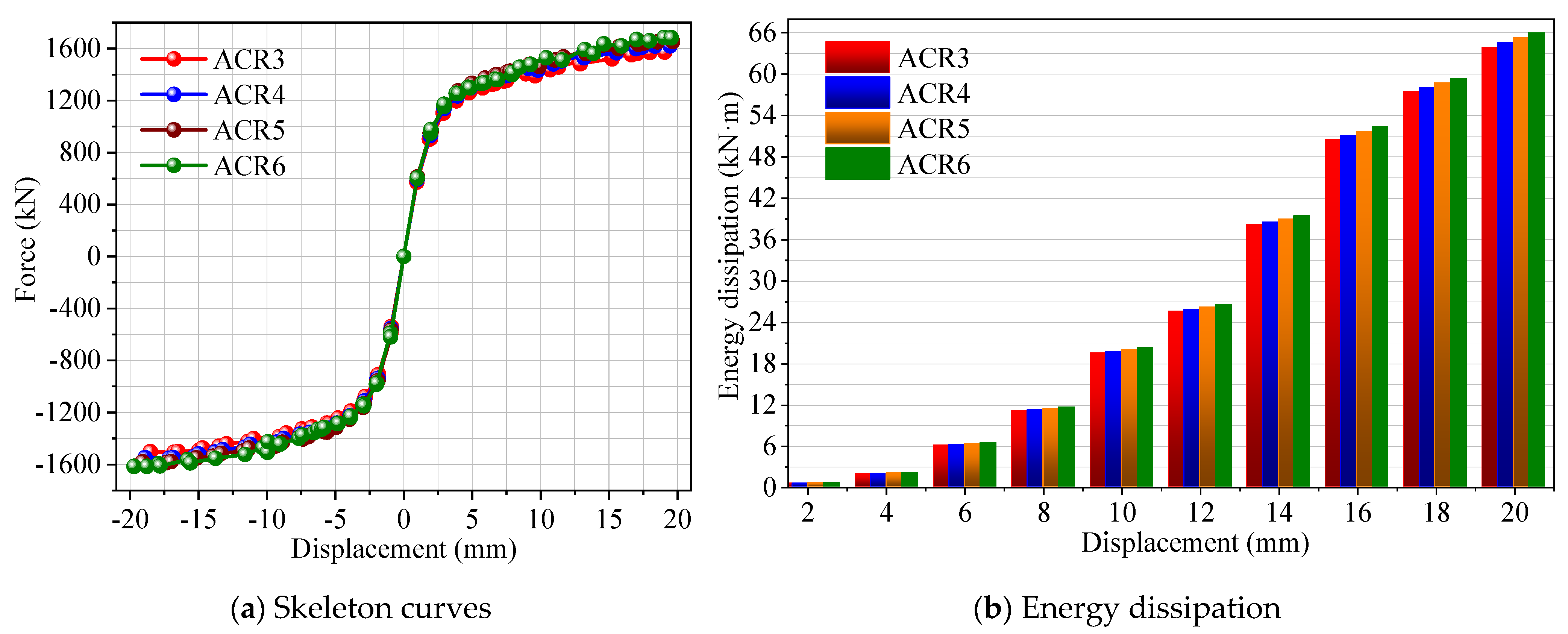
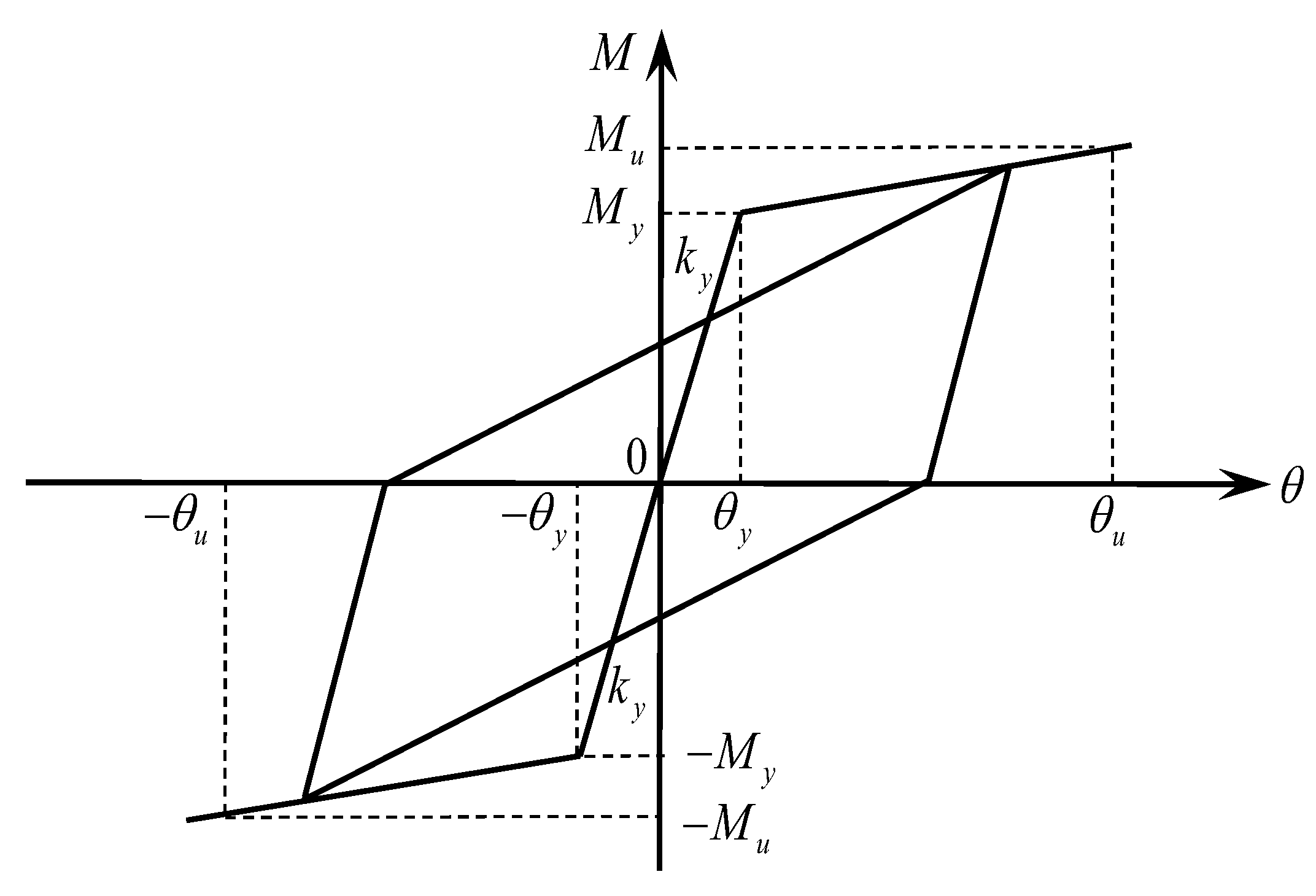
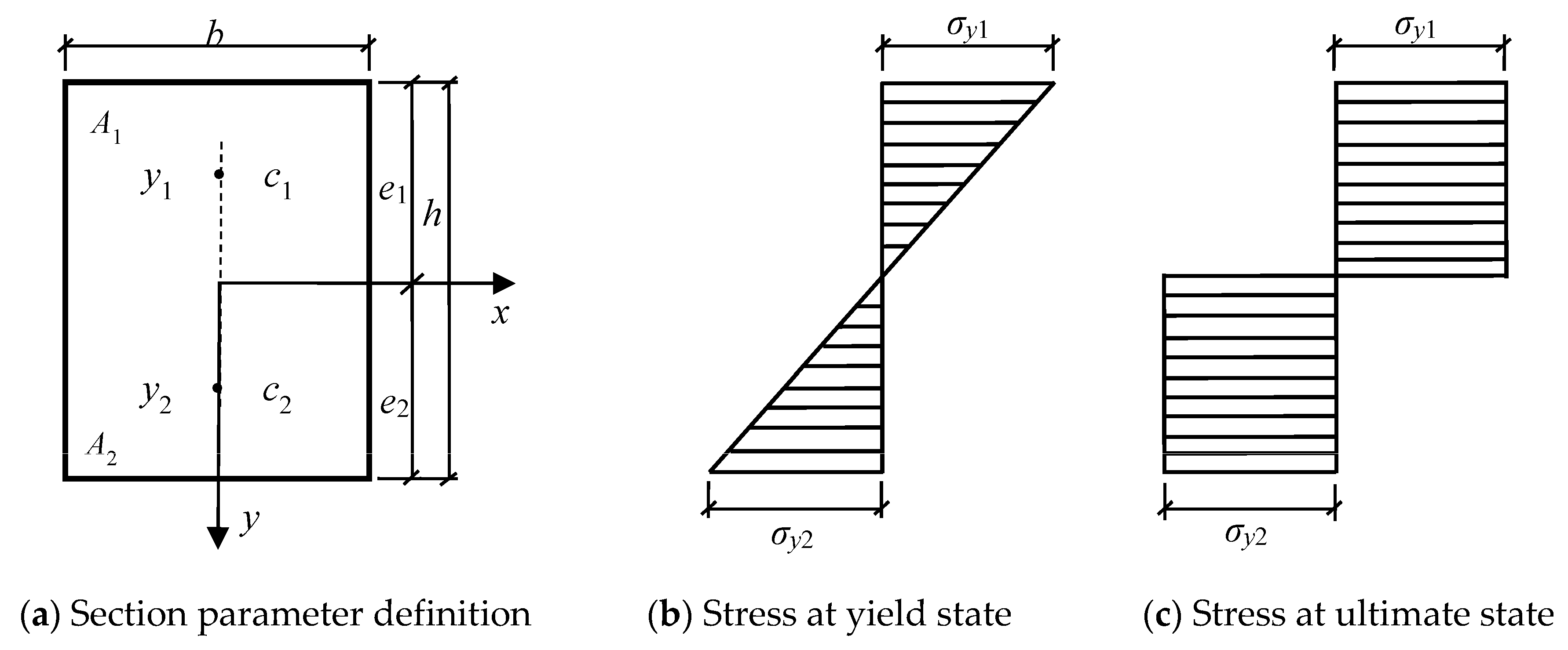
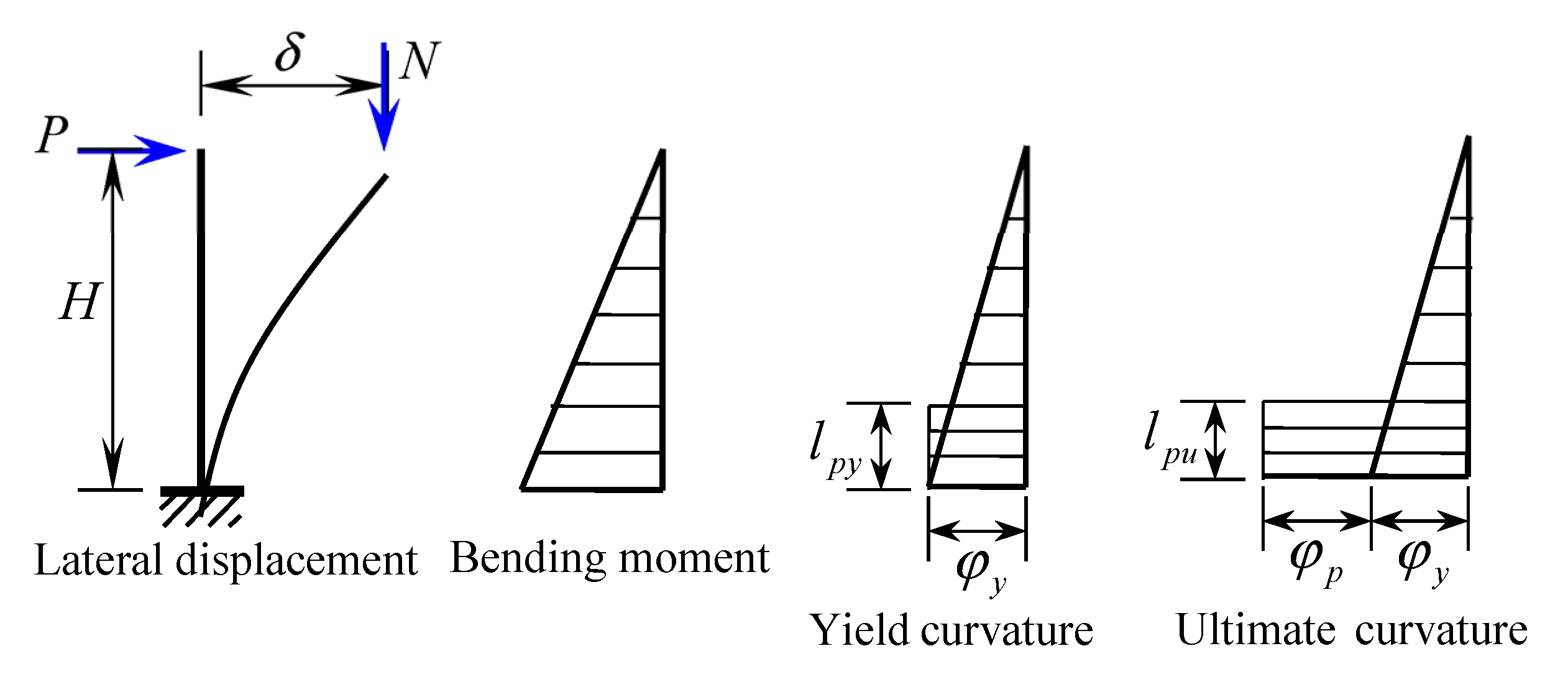


| Elasticity parameter | Young’s modulus | 3 × 1010 N/m2 | |||
| Poisson’s ratio | 0.2 | ||||
| Plastic parameter | Expansion angle | Eccentricity | fb0/fc0 | k | Viscosity parameter |
| 30 | 0.1 | 1.16 | 0.6667 | 0.0005 | |
| Steel Type | Yield Strength/MPa | Ultimate Strength/MPa |
|---|---|---|
| B12 | 389 | 540 |
| B8 | 330 | 484 |
| B6 | 400 | 546 |
| Component Category | Material | Element Type | Mesh Size | Element Number | Node Number | Constitutive Model |
|---|---|---|---|---|---|---|
| Wall body | Concrete | C3D8R | 10 mm | 1660 | 25,772 | Plastic damage constitutive |
| Rebar mesh | Steel | T3D2 | 10 mm | 2506 | 24,716 | Bilinear dynamic strengthening constitutive |
| Model Number | Mesh Size | Node Number | Element Number |
|---|---|---|---|
| 1 | 6 mm | 185,646 | 172,436 |
| 2 | 8 mm | 72,568 | 65,130 |
| 3 | 10 mm | 44,262 | 38,694 |
| 4 | 12 mm | 23,340 | 19,964 |
| 5 | 16 mm | 8100 | 6435 |
| 6 | 20 mm | 4800 | 3676 |
| Case Name | Interlocking Slot | Axial Compression Ratio | Mesh Size | Contact Interface | Friction Coefficient | ||
|---|---|---|---|---|---|---|---|
| Length | Number | Thickness | |||||
| LE10 | 10 mm | 3 | 30 mm | 0.5 | 10 mm | Hard contact | 0.5 |
| LE20 | 20 mm | 3 | 30 mm | 0.5 | 10 mm | Hard contact | 0.5 |
| LE30 | 30 mm | 3 | 30 mm | 0.5 | 10 mm | Hard contact | 0.5 |
| LE40 | 40 mm | 3 | 30 mm | 0.5 | 10 mm | Hard contact | 0.5 |
| BNU1 | 20 mm | 1 | 20 mm | 0.5 | 10 mm | Hard contact | 0.5 |
| BNU2 | 20 mm | 2 | 20 mm | 0.5 | 10 mm | Hard contact | 0.5 |
| BNU3 | 20 mm | 3 | 20 mm | 0.5 | 10 mm | Hard contact | 0.5 |
| BNU4 | 20 mm | 4 | 20 mm | 0.5 | 10 mm | Hard contact | 0.5 |
| CNU1 | 30 mm | 1 | 20 mm | 0.5 | 10 mm | Hard contact | 0.5 |
| CNU2 | 30 mm | 2 | 20 mm | 0.5 | 10 mm | Hard contact | 0.5 |
| CNU3 | 30 mm | 3 | 20 mm | 0.5 | 10 mm | Hard contact | 0.5 |
| CNU4 | 30 mm | 4 | 20 mm | 0.5 | 10 mm | Hard contact | 0.5 |
| TH10 | 30 mm | 3 | 10 mm | 0.5 | 10 mm | Hard contact | 0.5 |
| TH20 | 30 mm | 3 | 20 mm | 0.5 | 10 mm | Hard contact | 0.5 |
| TH30 | 30 mm | 3 | 30 mm | 0.5 | 10 mm | Hard contact | 0.5 |
| TH40 | 30 mm | 3 | 40 mm | 0.5 | 10 mm | Hard contact | 0.5 |
| ACR3 | 30 mm | 3 | 20 mm | 0.3 | 10 mm | Hard contact | 0.5 |
| ACR4 | 30 mm | 3 | 20 mm | 0.4 | 10 mm | Hard contact | 0.5 |
| ACR5 | 30 mm | 3 | 20 mm | 0.5 | 10 mm | Hard contact | 0.5 |
| ACR6 | 30 mm | 3 | 20 mm | 0.6 | 10 mm | Hard contact | 0.5 |
| Cases | Yield Point | Peak Point | Total Energy Dissipation | Ductility Coefficient | |||||
|---|---|---|---|---|---|---|---|---|---|
| Δy (mm) | Py (kN) | AP | Δu (mm) | Pu (kN) | AP | Energy (kN·m) | AP | ||
| LE10 | 3.63 | 1009.40 | —— | 15.89 | 1243.50 | —— | 473.00 | —— | 4.37 |
| LE20 | 3.73 | 1227.80 | 21.64% | 16.02 | 1428.00 | 14.84% | 552.00 | 16.70% | 4.30 |
| LE30 | 3.76 | 1489.60 | 47.57% | 16.56 | 1657.50 | 33.29% | 562.00 | 18.82% | 4.41 |
| LE40 | 3.83 | 1632.40 | 61.72% | 16.87 | 1867.50 | 50.18% | 576.00 | 21.78% | 4.41 |
| Cases | Yield Point | Peak Point | Total Energy Dissipation | Ductility Coefficient | |||||
|---|---|---|---|---|---|---|---|---|---|
| Δy (mm) | Py (kN) | AP | Δu (mm) | Pu (kN) | AP | Energy (kN·m) | AP | ||
| BNU1 | 3.69 | 1026.0 | —— | 15.52 | 1347.0 | —— | 442.48 | —— | 4.20 |
| BNU2 | 3.81 | 1038.0 | 1.17% | 15.89 | 1389.0 | 3.12% | 490.28 | 10.80% | 4.17 |
| BNU3 | 3.73 | 1052.4 | 2.57% | 16.02 | 1428.0 | 6.01% | 552.13 | 24.78% | 4.30 |
| BNU4 | 3.84 | 1064.4 | 3.74% | 16.45 | 1447.5 | 7.46% | 575.28 | 30.01% | 4.28 |
| CNU1 | 3.34 | 1218.0 | —— | 16.02 | 1633.5 | —— | 479.83 | —— | 4.79 |
| CNU2 | 3.53 | 1254.0 | 2.96% | 16.15 | 1647.0 | 0.83% | 531.92 | 10.86% | 4.58 |
| CNU3 | 3.76 | 1276.8 | 4.83% | 16.56 | 1657.5 | 1.47% | 561.91 | 17.11% | 4.41 |
| CNU4 | 3.83 | 1293.6 | 6.21% | 16.78 | 1674.0 | 2.48% | 586.97 | 22.33% | 4.38 |
| Cases | Yield Point | Peak Point | Total Energy Dissipation | Ductility Coefficient | |||||
|---|---|---|---|---|---|---|---|---|---|
| Δy (mm) | Py (kN) | AP | Δu (mm) | Pu (kN) | AP | Energy (kN·m) | AP | ||
| TH10 | 3.73 | 506.66 | —— | 15.11 | 680.11 | —— | 296.38 | —— | 4.05 |
| TH20 | 3.73 | 600.62 | 18.54% | 17.46 | 801.96 | 17.92% | 401.25 | 35.38% | 4.68 |
| TH30 | 3.74 | 747.48 | 47.53% | 17.96 | 966.02 | 42.04% | 465.97 | 57.22% | 4.80 |
| TH40 | 3.74 | 822.23 | 62.29% | 17.98 | 1065.48 | 56.66% | 512.56 | 72.94% | 4.80 |
| Cases | Yield Point | Peak Point | Total Energy Dissipation | Ductility Coefficient | |||||
|---|---|---|---|---|---|---|---|---|---|
| Δy (mm) | Py (kN) | AP | Δu (mm) | Pu (kN) | AP | Energy (kN·m) | AP | ||
| ACR3 | 3.62 | 1039.00 | —— | 15.87 | 1591.50 | —— | 543.55 | —— | 4.38 |
| ACR4 | 3.69 | 1051.00 | 1.15% | 16.12 | 1630.50 | 2.45% | 552.21 | 1.59% | 4.36 |
| ACR5 | 3.76 | 1064.00 | 2.41% | 16.56 | 1657.50 | 4.15% | 561.91 | 3.38% | 4.41 |
| ACR6 | 3.83 | 1078.00 | 3.75% | 16.98 | 1687.50 | 6.03% | 567.85 | 4.47% | 4.44 |
| Case | Py/(kN) | δy/(mm) | Pu/(kN) | δu/(mm) | ||||||||
|---|---|---|---|---|---|---|---|---|---|---|---|---|
| Simulation | Theory | Error | Simulation | Theory | Error | Simulation | Theory | Error | Simulation | Theory | Error | |
| LE20 | 1227.80 | 1265.56 | 2.98% | 3.73 | 3.58 | 4.19% | 1428.00 | 1465.23 | 2.54% | 16.02 | 16.15 | 0.80% |
| BNU2 | 1038.00 | 1025.98 | 1.17% | 3.81 | 3.65 | 4.38% | 1389.00 | 1435.61 | 3.25% | 15.89 | 16.82 | 5.53% |
| TH20 | 600.62 | 650.50 | 7.67% | 3.73 | 3.72 | 0.27% | 801.96 | 808.28 | 0.78% | 17.46 | 17.16 | 1.75% |
| TH40 | 822.23 | 805.36 | 2.09% | 3.74 | 3.62 | 3.31% | 1065.48 | 1114.32 | 4.38% | 17.98 | 18.24 | 1.43% |
| ACR4 | 1051.00 | 1032.45 | 1.80% | 3.69 | 3.64 | 1.37% | 1630.50 | 1638.56 | 0.49% | 16.12 | 15.72 | 2.54% |
| ACR6 | 1078.00 | 1047.21 | 2.94% | 3.83 | 3.59 | 6.69% | 1687.50 | 1768.21 | 4.56% | 16.98 | 17.59 | 3.47% |
Disclaimer/Publisher’s Note: The statements, opinions and data contained in all publications are solely those of the individual author(s) and contributor(s) and not of MDPI and/or the editor(s). MDPI and/or the editor(s) disclaim responsibility for any injury to people or property resulting from any ideas, methods, instructions or products referred to in the content. |
© 2023 by the authors. Licensee MDPI, Basel, Switzerland. This article is an open access article distributed under the terms and conditions of the Creative Commons Attribution (CC BY) license (https://creativecommons.org/licenses/by/4.0/).
Share and Cite
Wu, X.; Wang, Y.; Ji, S.; Liu, M.; Wang, D. Numerical Study on Mechanical Behaviors of New Type of Steel Shear-Connection Horizontal Joint in Prefabricated Shear Wall Structure. Buildings 2023, 13, 3000. https://doi.org/10.3390/buildings13123000
Wu X, Wang Y, Ji S, Liu M, Wang D. Numerical Study on Mechanical Behaviors of New Type of Steel Shear-Connection Horizontal Joint in Prefabricated Shear Wall Structure. Buildings. 2023; 13(12):3000. https://doi.org/10.3390/buildings13123000
Chicago/Turabian StyleWu, Xiaohui, Yanfeng Wang, Shaofeng Ji, Mengze Liu, and Dayang Wang. 2023. "Numerical Study on Mechanical Behaviors of New Type of Steel Shear-Connection Horizontal Joint in Prefabricated Shear Wall Structure" Buildings 13, no. 12: 3000. https://doi.org/10.3390/buildings13123000
APA StyleWu, X., Wang, Y., Ji, S., Liu, M., & Wang, D. (2023). Numerical Study on Mechanical Behaviors of New Type of Steel Shear-Connection Horizontal Joint in Prefabricated Shear Wall Structure. Buildings, 13(12), 3000. https://doi.org/10.3390/buildings13123000





